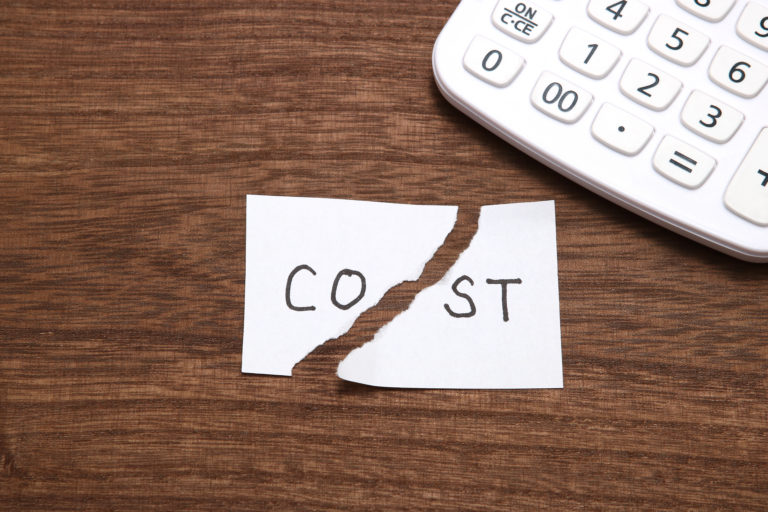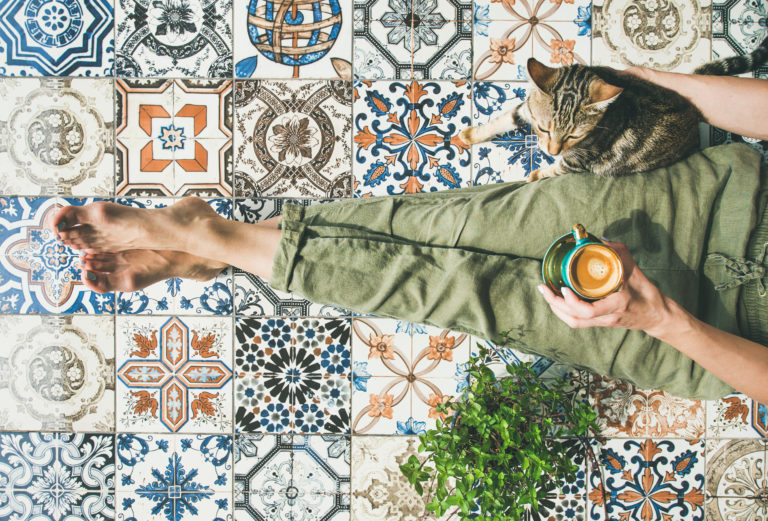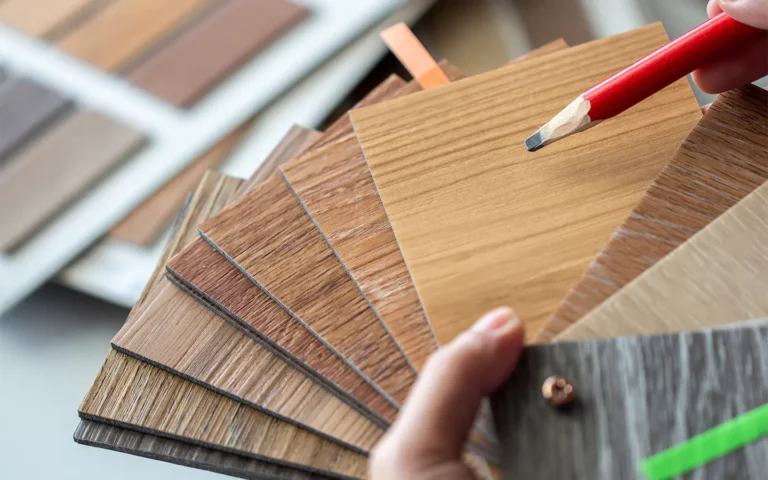This post may contain references or links to products from one or more partners of our parent company and/or subsidiaries of our parent company. For more information, visit this page.
October 1, 2020
So you’ve been diving into the endless different types of wood flooring and you’ve found yourself stuck between hickory vs. oak.
You’re not alone! The hickory vs. oak debate is one of the most common arguments we hear about in the flooring world.
It’s really a battle between the common-but-wonderful and the… well, slightly-less-common-but-still-wonderful.
Oak (or oak-look fake wood flooring at least) can be found in just about every house in America. Hickory, on the other hand, tends to be a bit rarer. Not, like, ebony flooring rare, but rare nonetheless.
That being said, hickory and oak are both fantastic options for hardwood flooring. And while there are advantages and disadvantages of hickory and oak flooring, deciding between the two often comes down to personal preference. It’s not really an “X is better than Y” situation.
But don’t worry! This isn’t one of those articles where we list one or two facts and leave you to try and piece together a conclusion from incomplete information.
Below, we’re going to make sure that you’re well-versed in all the advantages and disadvantages of hickory flooring and oak flooring. By the time you’re done with this article, you’ll have earned your degree in hickory vs. oak-ology (sorry, we’re non-accredited).
Let’s jump in!
Hickory vs. Oak Wood: What’s the Difference?
Oak and hickory trees grow all over the world, but the ones most commonly used for flooring are native to the US.
And when it comes to oak flooring, there are two main species to choose from: red oak and white oak. We’ll cover this a little bit more down below, but red oak wood tends to have (surprise!) reddish-brown hues while white oak wood has a much lighter tan or gray appearance.
Red and white oak each bring something special to the table in terms of grain pattern and durability too—but again, we’ll dive into that a bit more later.
Oak Trees Are Among the Most Common Lumber Trees
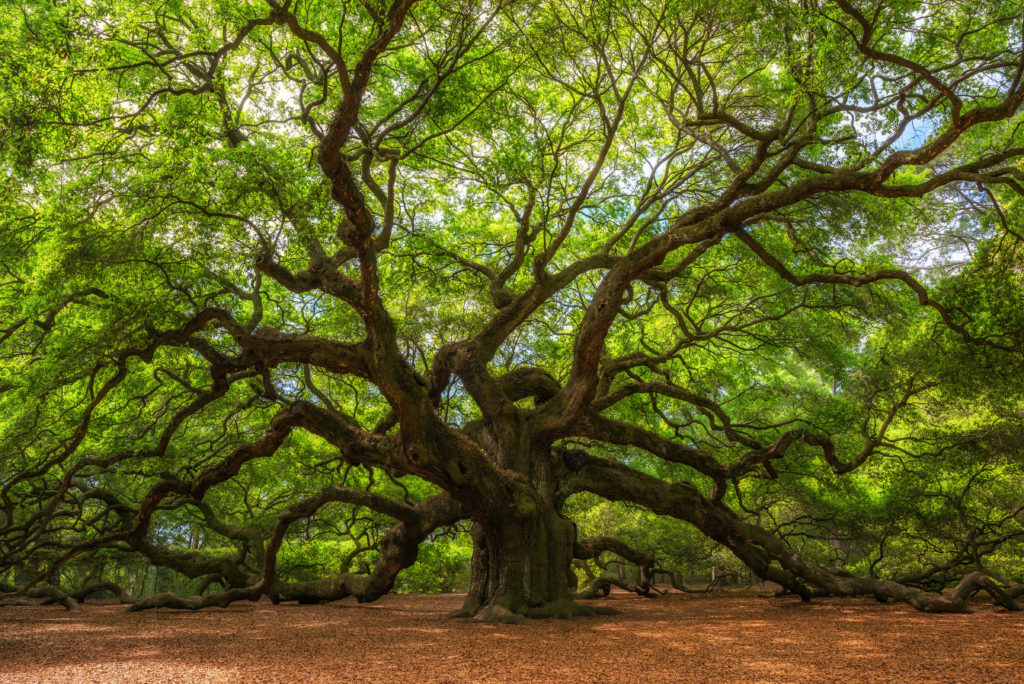
If you live in the United States or Canada and you’ve stepped outside (gasp!) there’s a good chance you’ve seen an oak tree at some point or another. They’re incredibly common in the Northern Hemisphere and especially so here in the States.
As of 2002, white and red oak were two of the ten most common trees in the United States. Ironically, these two types of oak are the only kinds of oak trees that are widely suitable for lumber.
Many Hickory Trees Are Also from North America
Hickory trees aren’t quite as common as oak trees, but of the 18 different species of hickory, 12 are native to North America. Unlike oak, most hickory trees produce wood that’s suitable for flooring. Some, like the Carya illinoinensis, even produce pecans!
Translation: if you’re worried about the disadvantages of hickory flooring, you can cross “endangered” off the list—hickory flooring is perfectly eco-friendly.
Anyways, unless you’re a tree-ologist (yes, we’re back to that), the biggest noticeable difference between hickory and oak trees are their leaves. Hickory leaves look vaguely like teardrops while oak leaves look more like stubby fingers.
Best Brands of 2024
Hickory vs. Oak Flooring: What’s The Difference?
Of course, if you’re comparing hickory vs. oak flooring, you’re probably not overly concerned about how those trees look before they’re chopped down, processed, and turned into planks. You want to know how they’re going to look in your home!
White and Red Oak Have Similar Grain Patterns, But Different Coloration
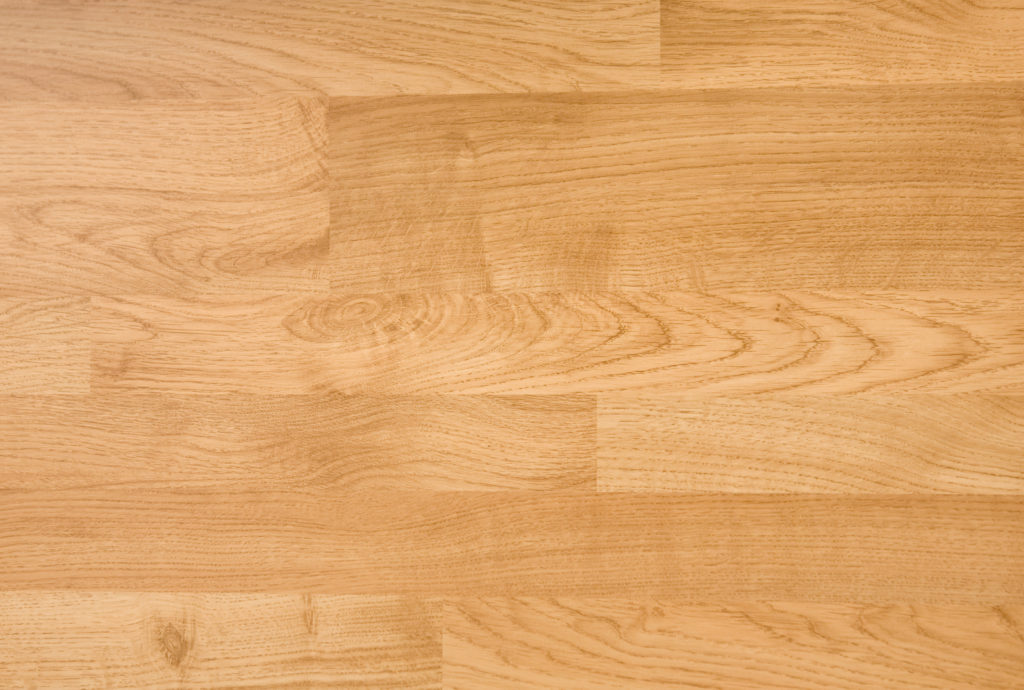
The biggest difference between white and red oak is in their coloration—not their grain patterns.
As we mentioned before, red oak tends to offer warmer tones while white oak is a bit paler. White oak flooring can also take on a bit of a golden appearance, but it usually comes down to the specific product and brand. It’s also possible to find darker-toned oak flooring that resembles teak flooring.
Red and white oak planks both offer rounder grain patterns than, say, douglas fir flooring—but compared to hickory, they’re much more uniform.
Hickory’s Grain May Be Its Biggest Appeal, but Its Color Is Beautiful Too
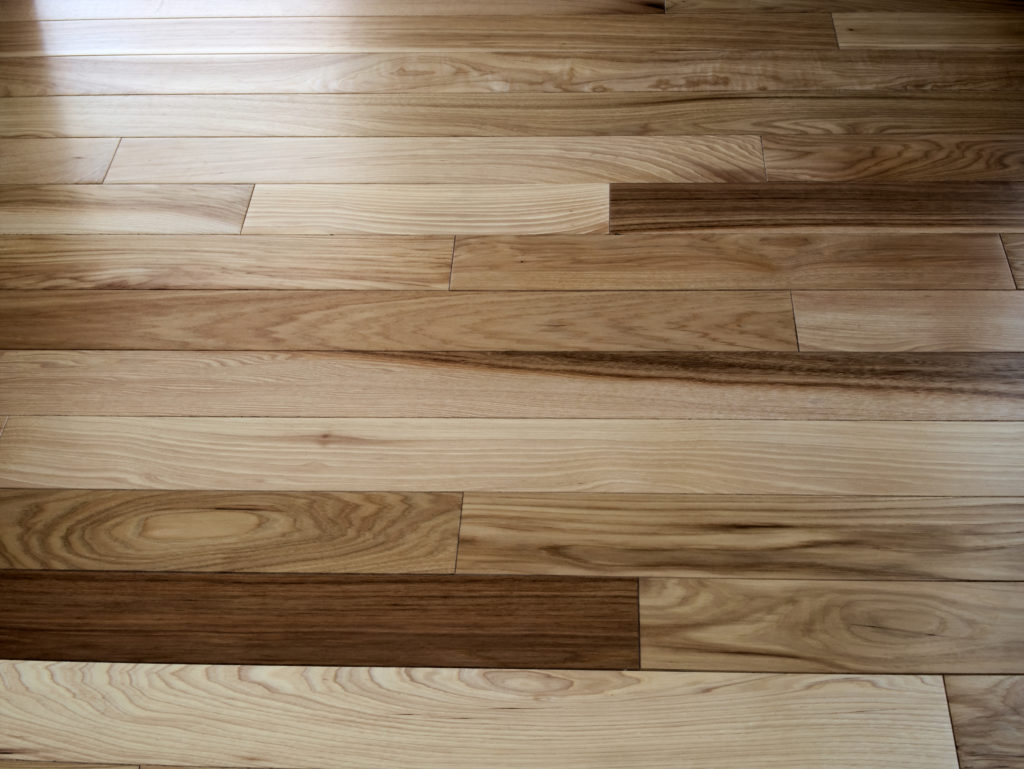
If you want something a bit less uniform, hickory flooring may be the way to go. Unlike oak planks (which are often nearly identical), hickory planks are incredibly varied. A houseful of hickory is unlikely to have even two or three identical planks.
Of course, depending on who you ask, this can be chalked up as one of the advantages or disadvantages of hickory flooring. It really just comes down to preference.
Some buyers consider this varied grain to be a disadvantage of hickory, and the planks are often described as “busy.” And while some can appear linear, most look like a Jimi Hendrix song that was somehow transformed into a piece of wood (not that that’s a bad thing).
In terms of color, hickory generally ranges from a creamy to golden brown. It tends to come in lighter shades, but it also takes a stain very well—so if you like the grain but want a darker color, you’re in luck.
In our humble opinion, hickory flooring’s variety is really what makes it so cool looking. It’s almost like each piece tells its own story!
Which is More Expensive: Oak or Hickory?
This is where things get pretty complicated. Hickory has a higher price ceiling, while oak has a lower bottom price. However, it’s entirely possible to find high-quality oak and high-quality hickory at similar prices.
But generally speaking, oak has a wider price range. And one clear disadvantage of hickory flooring is this: it’s easier to find an excellent deal on high-quality oak than it is to find an excellent deal on high-quality hickory.
If you don’t mind (or prefer) engineered wood, the cost to install engineered hardwood floors in either hickory or oak is relatively similar. Of course, that largely depends on the specific product you choose.
Translation: One of the Main Disadvantages of Hickory Flooring is That It’s (Usually) More Expensive than Oak
The biggest reason for the cost difference mostly comes down to supply. Hickory, while native to the United States, is less common than either red or white oak.
Still, unless you’re talking about reflooring an entire house, the average price of “good” hickory is only a bit higher than that of “good” oak. If you’re debating between hickory vs. oak flooring, the price point probably won’t be big enough to sway you one way or another. It also helps that most of the best hardwood floor brands offer tons of oak and hickory options.
How Much is Hickory Hardwood Flooring Exactly?
The price of hickory depends on the quality, but Home Depot sells solid hardwood hickory flooring for anywhere between $3.75–$11 per square foot. Oak starts at a similar price but tops out around $9.50.
Of course, we wouldn’t recommend buying any flooring from Home Depot (or any box store for that matter). It’s usually lower-quality and box store installation is notoriously horrible. Don’t believe us? Just take a look at the cork flooring Lowe’s and Home Depot sells.
Rather, we’d recommend finding a dedicated flooring store in your area. Local flooring retailers know everything there is to know about surfaces, and they can give you actual expert advice because flooring is all they do!
Is Hickory Hardwood More Durable than Oak?
Ah, the hickory vs. oak durability question. While many people think of these two types of wood as just about equal when it comes to hardness, hickory is actually much more durable than oak.
How do we know? Because hickory ranks fairly high on the Janka scale, which we use to test wood’s hardness. This makes hickory a great option if you’re looking for the best wood flooring for dogs or kids.
That’s not to say that oak flooring isn’t strong—it most certainly is—but hickory can handle a bit more abuse.
Hickory vs. Oak Flooring Durability
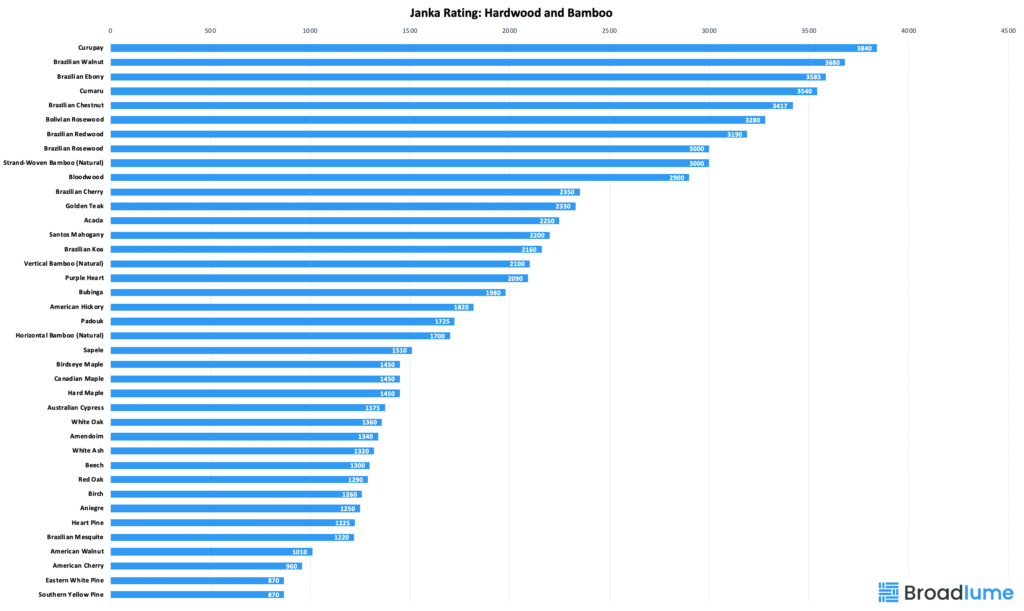
Just how much more durable is hickory than oak? Let’s go to the chart.
- Hickory has an average Janka rating of 1820, which is considered extremely durable.
- White oak, on the other hand, ranks at 1360—and red oak is even lower at 1290.
It’s worth noting that oak is considered the “industry standard” when it comes to hardwoods, so hickory’s massive 1820 rating is really high. There might be disadvantages to hickory flooring, but like its eco-friendliness, durability is not one of them.
Is hickory the most durable wood flooring in the world? No. But it sure beats oak—enough to make a pretty big difference when it comes to durability.
Hickory vs. Oak: Which Is Easier to Install?
Aside from appearance, the biggest distinguishing factor between hickory vs. oak might be ease of installation.
Because hickory is so much harder than oak, it’s also harder to work with. Of course, if you’re hiring a professional to cut and install your flooring for you (and we would highly recommend it unless you’re a DIY wood flooring pro), this won’t be an issue.
Hickory is More Resistant to Standard Steel Saw Blades
If you’re cutting hickory planks to match the contours of your home, you’ll need to use carbon-tipped blades rather than standard steel. In general, this doesn’t dramatically raise the price of installing your floors, but it might add some time to the project.
Of course, while some see this as a disadvantage of hickory flooring, the benefit is that once your floors are down, they won’t be as prone to damage.
And Oak is Easier to Cut
Oak, however, can easily be cut with high-speed steel blades. Of all the types of wood flooring out there, oak is actually one of the easiest hardwoods to install.
But If You Buy Engineered Wood, You Won’t Have to Worry Either Way
These issues with installation only apply to solid wood, of course. If you buy an engineered product, you won’t have to worry about cutting through as much solid wood—meaning you can use whatever type of saw you want.
Hickory vs. Oak: Which Floor Has the Better Resale Value?
One consideration for many homeowners is how a new floor will affect their home’s resale value. The good news is that hardwood floors are excellent for resale value across the board.
At Face Value, Hickory May Be Worth More Because It’s Rarer
On paper, hickory floors tend to be more valuable than oak—but the reason may simply come down to the fact that they’re rarer to find in homes. But of course, it all comes down to the potential homebuyers. There’s no knowing what they’ll appreciate when it comes to hickory vs. oak flooring.
But, Oak Floors May Be More Widely Appreciated
On the flip side, oak floors are popular for a reason. Oak is the industry standard hardwood floor for a reason—people love it! This wide appreciation makes it an easy and safe bet for increasing your home’s resale value.
The Disadvantages of Hickory Flooring
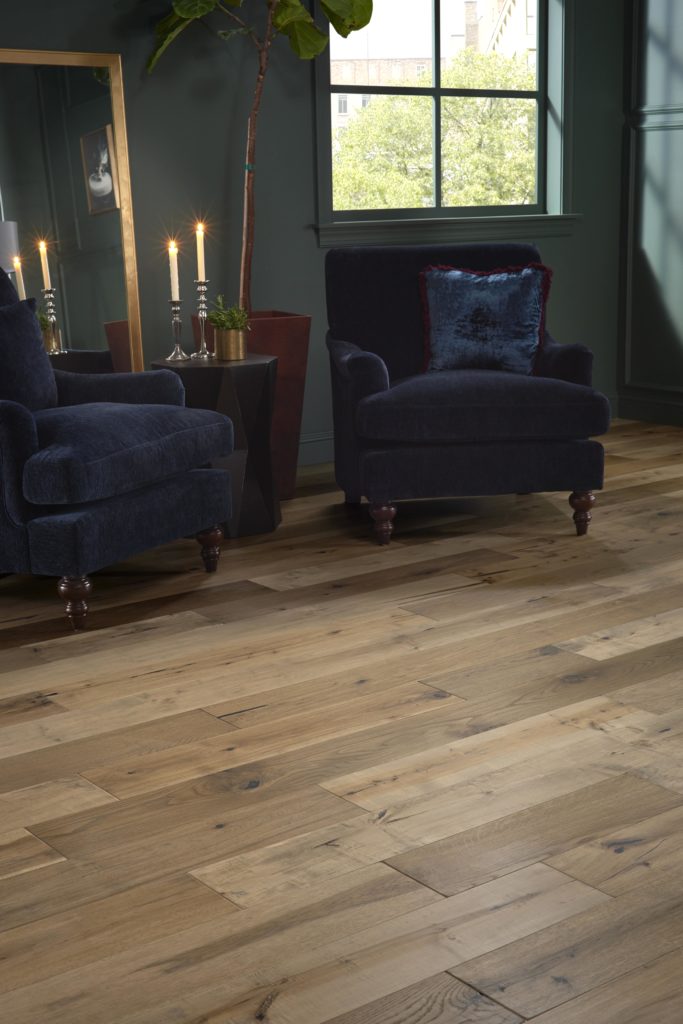
If you ask us, there aren’t any true disadvantages of hickory flooring—especially if you’re comparing hickory vs. oak floors. In fact, the disadvantages of hickory flooring we’ll go into below simply come down to buyer preference.
If you’ve already accepted the cons of hardwood flooring in general—that it’s not ideal for mudroom flooring, that it’s risky to do a wood floor bathroom unless you’re using a waterproof fake wood flooring product like Mohawk’s RevWood, etc. etc.—you don’t have much to worry about.
That being said, these are the disadvantages of hickory flooring (such as they are):
Hickory Flooring’s Unusual Grain May Be a Turn-Off
We think that hickory’s random grain is absolutely gorgeous, but if you want something more uniform in appearance, it’s probably not the best choice. There are plenty of light-colored wood flooring types that are less sporadic in their grain, like ash flooring (or even pine flooring, for that matter).
And Like We Mentioned, Hickory Wood is a Bit Harder to Work With
As we said before, hickory wood is a bit tougher to cut than oak is. While this is great for durability, it does make hickory planks harder to cut to size.
Another Hickory Flooring Disadvantage: It’s a Bit More Expensive
The only “real” disadvantage of hickory flooring is that it can be a bit more expensive when compared to oak. However, high-end oak flooring can cost virtually the same as hickory, and the two are relatively comparable. So again—it’s all relative.
The Advantages of Hickory Flooring
Back to the fun stuff! Many of the disadvantages of hickory flooring we mentioned are, with a slight change of perspective, also its benefits. We know, we know.
While Some See Chaos in Hickory’s Grain, Others See Beauty
With hickory flooring, just about every plank is unique in terms of both grain pattern and tone. And if you love hickory’s grain but aren’t so hot on the color variation, it’s not too hard to find hickory flooring with a more uniform look. It’ll probably come with a heightened price tag though.
If You’re Comparing Hickory vs. Oak, Hickory Is the More Durable Choice
Because hickory flooring is so hard, it’s difficult to dent, scratch, or otherwise damage it. Quality hickory floors can last for decades—or even centuries—with basic upkeep.
The Disadvantages of Oak Flooring
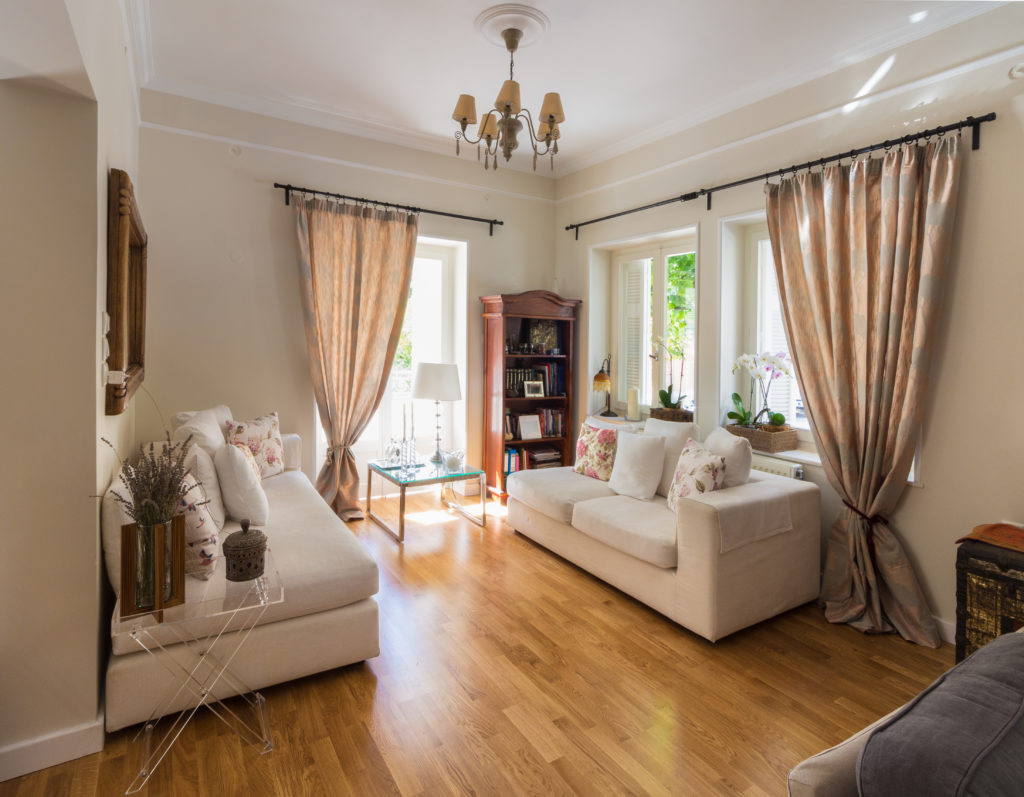
Oak isn’t known for having any big disadvantages. This is one of the reasons it’s so common—it’s hard not to like it! The wood is durable and looks great. And while it’s not water-resistant wood flooring per se, it does handle water better than some other types of wood flooring. And, of course, it’s easy to stain.
But if you’re comparing oak vs. hickory flooring, you will find that oak comes with a couple of small disadvantages:
Oak Isn’t as Durable as Hickory Flooring
Both red and white oak have great Janka ratings (again, oak is the industry standard for hardness). But compared to hickory, they’re much softer. This could become a problem for people with pets, children, or high-traffic needs.
Which Means Oak Floors May Require More Refinishing than Hickory Floors
As red and white oak aren’t quite as hard as hickory, oak flooring may require more frequent refinishing. Of course, this depends on a lot of factors—the specific product, the finish, the level of traffic on the floor, etc.
The Advantages of Oak Flooring
Again, when comparing hickory vs. oak flooring, you’ll find that oak scores well across the board—but you knew that already! Here are a few of the most common reasons:
Oak Is Easier to Cut and Work With
Another advantage that oak has over hickory is that it’s easier to cut and work with. Carbon-tipped steel blades aren’t necessary for cutting oak like they are for cutting hickory.
Translation: when we talk about the installation concerns of hickory vs. oak, oak is the easier one to put in.
Oak is Often Cheaper Than Hickory
We covered this earlier, but one of the main disadvantages of hickory flooring is that it’s usually more expensive than oak. And of course, that disadvantage of hickory flooring is an advantage for oak flooring!
Oak Has a More Regular Grain Pattern
Again, we’re repeating ourselves here—but it’s worth noting that oak’s more regular grain pattern makes it attractive to a wider audience. This can be a big plus if you’re considering the pros and cons of hickory vs. oak when it comes to resale value.
Overall, Between Hickory vs. Oak Flooring, Which is the Better Choice?
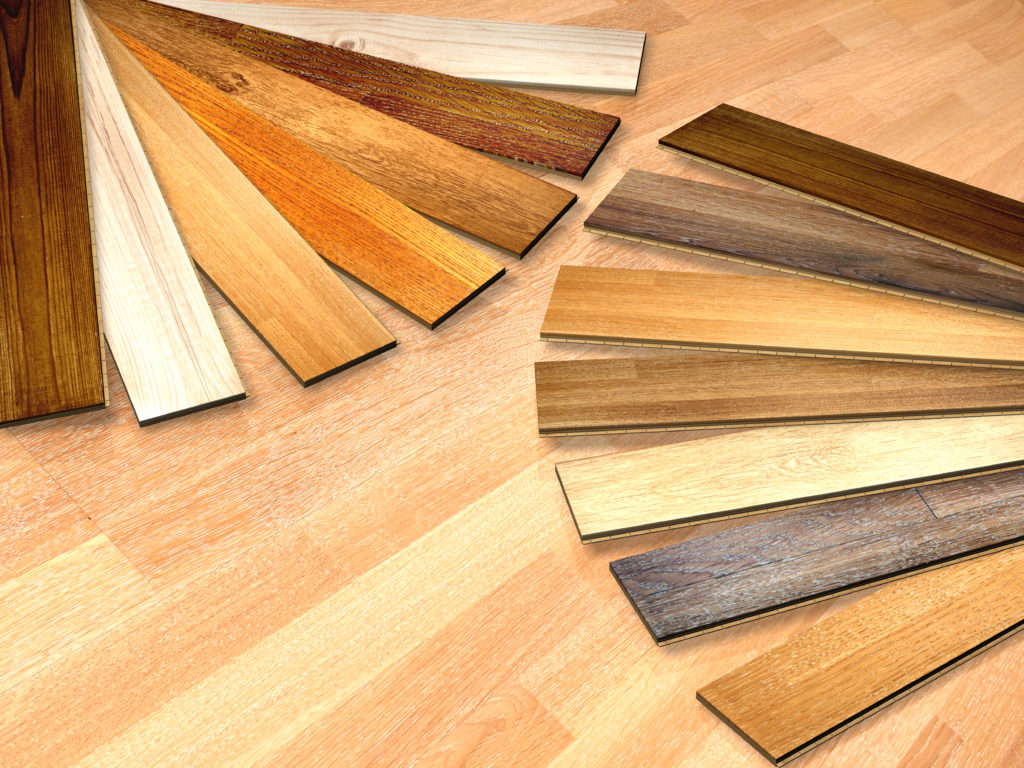
All in all, it really comes down to personal preference. Hickory is a little more unique and a bit more durable. Oak can be a little less expensive and might be a safer choice from a resale value perspective. Of all the types of flooring you could consider, you really can’t go wrong with either one!
And Remember: You Can Get The Appearance of Oak or Hickory With a Hardwood Floor Alternative
If you want the look of oak or hickory but don’t want to deal with the price (or disadvantages) or these wood floors, you can always opt for any number of faux wood floors.
Laminate and Vinyl Are The Most Popular Hardwood Floor Alternatives
If you love wood floor patterns but don’t want to deal with the hassle of installing hardwood flooring, both laminate and vinyl are high-quality options. In fact, in terms of hardwood floor alternatives, these are two of the most durable, high-quality choices.
One disadvantage of hickory flooring—or oak flooring for that matter—is that it’s not waterproof. Wood-look laminate or vinyl can be a great substitute for this very reason.
Plus, laminates and many types of vinyl flooring are nearly indistinguishable from finished hardwood flooring once installed. They’re also two of the most scratch-resistant flooring options available. Don’t believe us? Read some Pergo Extreme reviews—Pergo is one of the most popular vinyl floors around, and people love it for a reason.
Oh, and bonus point: laminate and vinyl almost always come as click-together flooring, used to make so-called “floating floors”. Floating setups are some of the easiest flooring to install—and while there might be some disadvantages of floating floors, installation price is not among them.
You Could Also Consider Wood-Look Tile, Wood-Look Hemp Flooring, or Even Wood-Look Concrete!
Everyone knows that tile flooring is classy. But recently, innovations in certain types of tile have made this material competitive with top-notch hardwood alternatives. Seriously!
Wood-look porcelain tile offers all the advantages of a tile floor—waterproofing, scratch-resistance, etc.—with a gorgeous wood-grain look. And now that you can buy snap-together tile flooring, it can be installed more cheaply and easily than ever. Want to see how tile compares to other fake wood floors? Read up on the pros and cons of tile vs. laminate.
Hemp flooring is another great middle road if you’re deciding between hickory vs. oak. It offers beautiful grain visuals (like hickory) with a ton of durability (like oak). Plus, it’s one of the most eco-friendly flooring options available!
Concrete flooring that looks like wood is another super-neat option. You won’t believe how well concrete flooring can mirror the appearance and texture of just about any kind of wood, including hickory and oak.
Plus, as long as you have a concrete subfloor, you can put wood-look concrete just about anywhere, inside or outside of your home. And if you’re wondering what subflooring is, it’s simply the support material underneath your finished floor.
And again—you can do away with many of the disadvantages of hickory and oak flooring by using any one of these alternative materials.
Hickory vs. Oak Flooring: Our Conclusion
We hope we’ve fulfilled our promise to tell you everything you need to know about the hickory vs. oak flooring debate. You’ve seen the advantages and disadvantages of hickory flooring, the advantages and disadvantages of oak flooring, and everything in between. You’ve even seen some nifty fake wood flooring options that can capture the best of both of these materials!
Now, the only thing left to do is talk about where to buy your floors. Our advice: find a flooring store in your area. Flooring dealers know more about surfaces than we could ever hope to learn—so go right to the source, whether you’re buying hickory or oak floors (or neither)!
And for more info on all things flooring, read up on:
- The Pros and Cons of Engineered Bamboo Flooring
- 5 Amazing Sunroom Flooring Options
- The Advantages and Disadvantages of Cork Flooring
- Choosing Wood Floor Colors: The 2020 Guide
- Carpet or Hardwood in Bedrooms: Which is Better?
- How Much Does it Cost to Replace Carpet With Hardwood?
- Carpet vs. Laminate: The *Real* Pros & Cons
- A Guide to Peel-and-Stick Carpet Tiles (& 9 Reasons They’re Amazing)
About The Author

Christian Southards
October 1, 2020
Christian is a freelance everything-writer, editor, and interior design nerd. When he’s not writing about flooring and remodeling, he’s either writing news for the California American Legion or working with his hands on his house. His favorite type of flooring is hardwood, but admits to having carpet in his bedroom.

